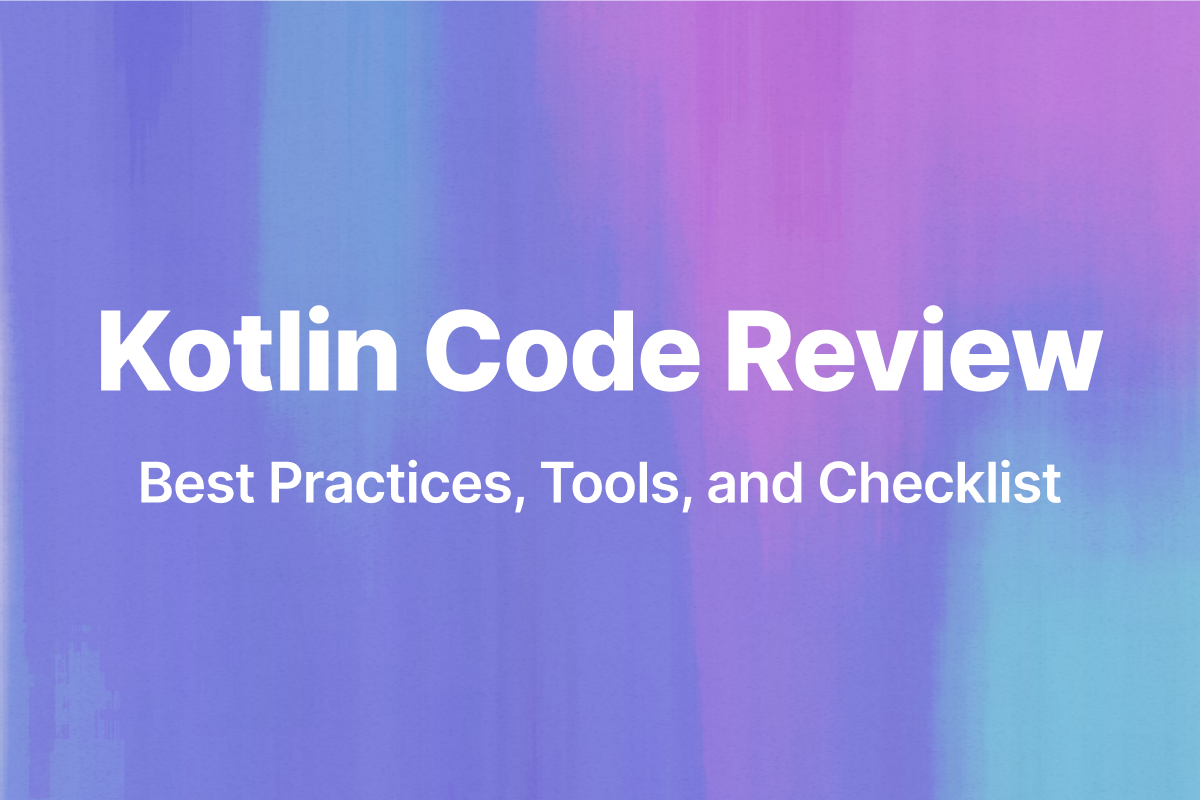Kotlin enables expressive, concise, and safe code—but that comes with trade-offs.
Features like null safety, DSLs, coroutines, and higher-order functions can easily be misused, making reviews critical.
A Kotlin code review isn’t just about bug detection; it’s about preserving architectural clarity, ensuring idiomatic usage, and maintaining long-term maintainability.
Reviewing Kotlin code requires context. Reviewers must go beyond syntax and understand the language’s functional and asynchronous paradigms. The right process, tools, and checklist can streamline this and drive better software outcomes.
What is a Kotlin code review and why does it matter?
A Kotlin code review is the technical and architectural validation of Kotlin source code. It identifies logic flaws, design issues, style violations, and non-idiomatic patterns. Without reviews, Kotlin’s flexibility can lead to cryptic or fragile implementations.
Read: Top Code Issues AI Code Review Agent Can Catch and Fix
Kotlin’s expressive syntax allows multiple ways to solve the same problem. This flexibility increases the risk of inconsistent logic and poor abstraction. Reviews prevent these issues early in the lifecycle, reducing bugs and keeping the codebase clean and scalable.
What are the best practices for Kotlin code reviews?
Focus on readability first
Readable code scales better than clever code. Kotlin encourages brevity, but that can turn into cryptic one-liners if not handled with care. Reviewers should prioritize clarity over compactness. For instance:
// Bad
val result = items.filter { it.active }.map { it.name }.sorted()
// Better
val activeNames = items
.filter { it.active }
.map { it.name }
.sorted()
Break long chains into intermediate steps when the operation isn’t immediately obvious. Avoid deep nesting—prefer early returns and smart restructuring.
Stick to the Kotlin style guide
Kotlin has an official style guide. Automated tools can check indentation, spacing, line length, and naming. Still, human reviewers must ensure consistent logic and style beyond what linters catch.
Kotlin naming conventions differ from Java—interfaces shouldn’t start with I, for example. Function names should describe behavior clearly, especially for extension functions.
Watch for null safety misuse
Null safety is Kotlin’s core advantage, but misused nullables can still cause issues. Code like someVar!! is an anti-pattern. Instead, reviewers should check for safe calls (?.), smart casting, and good use of require, check, and Kotlin’s result-based error handling.
Avoid nullable types where non-null makes more sense. If a value is always initialized, don’t declare it as nullable.
Validate API and modularity decisions
Good Kotlin code is modular, testable, and encapsulated. Reviewers should ask:
- Are functions small and single-purpose?
- Is logic decoupled from the Android or platform-specific layer?
- Are extension functions enhancing readability or hiding complexity?
Public APIs must remain minimal. Exposing internals through poorly scoped functions (e.g., using public instead of internal) opens the codebase to misuse and tight coupling.
Check coroutine usage carefully
Kotlin’s coroutines are powerful—but dangerous when misunderstood. During review, confirm:
suspendfunctions aren’t blockingwithContextis used for thread shiftinglaunchisn’t leaking scope- Lifecycle-aware scopes are used in Android
Improper coroutine handling leads to memory leaks, deadlocks, or unexpected behavior in concurrent systems.
What tools help with Kotlin code reviews?
1- Bito: An AI-powered code review assistant
Bito leads the toolchain for Kotlin code review. It analyzes pull requests using contextual understanding of Kotlin idioms and project architecture. It doesn’t just flag issues—it explains them in human-readable language and suggests fixes based on best practices.
Key features:
- Works inside GitHub, GitLab, and Bitbucket
- Highlights anti-patterns specific to Kotlin
- Offers test coverage feedback, performance flags, and modularity issues
- Understands coroutine misuse and async patterns
For Kotlin teams using microservices, Jetpack Compose, or multiplatform codebases, Bito significantly reduces review overhead and increases consistency.
2- Static analysis: Detekt, Ktlint, SonarQube
Automated analysis finds many of the issues early:
- Detekt: Flags long functions, complexity, unused code, magic numbers, and architectural smells.
- Ktlint: Ensures formatting and style align with Kotlin conventions. Can auto-format on save.
- SonarQube: Provides quality gates and historical code metrics. Integrates with CI pipelines.
These tools should run automatically on every commit or pull request. But human review remains essential to catch context-specific issues.
3- IDE features: IntelliJ IDEA
JetBrains’ IntelliJ IDEA offers first-class support for Kotlin reviews:
- In-editor inspections suggest improvements in real time
- Code With Me enables remote pair reviews
- Structure view helps reviewers quickly understand code layout
Reviewers should make full use of annotations, inspection levels, and code folding features for efficient browsing.
How to choose the best Kotlin code review tool for your team
Choosing the right tool depends on team size, project complexity, workflow, and integration needs. Here’s how to evaluate:
| Evaluation area | Questions to ask |
|---|---|
| Project scope | Is it a mobile app, backend, or multiplatform? Do you use coroutines heavily? |
| Team workflow | Do reviews happen on GitHub? Do you use merge requests or trunk-based dev? |
| Automation level | Do you want code suggestions, or just formatting enforcement? |
| AI support | Does the tool analyze logic and structure beyond style? |
| Integration support | Does it work with your CI/CD, IDE, or VCS system? |
| Customization | Can you define custom rules for architecture or module boundaries? |
Use case examples:
- A startup building a Kotlin Multiplatform app with limited reviewers → Use Bito + Ktlint
- An enterprise Android app with complex architecture → Use Bito + Detekt + SonarQube
- A solo dev or small team using IntelliJ IDEA → Use IDE inspections + Bito
Prioritize tools that reduce reviewer fatigue and promote consistent review velocity.
What is a complete Kotlin code review checklist?
Here’s a structured Kotlin code review checklist covering all essential areas:
| Category | Review focus |
|---|---|
| Readability | Clear naming, no deep nesting, concise but understandable code |
| Style | Follows Kotlin conventions, consistent formatting, no commented-out code |
| Null safety | Avoids !!, uses require/check, safe calls where needed |
| API design | Minimal visibility, clear separation of layers, good use of extension funcs |
| Testing | Unit tests exist, meaningful test names, edge cases handled |
| Performance | No unnecessary object allocations, lazy evaluation where needed |
| Coroutines | Proper scope use, no blocking in suspend, error handled via runCatching |
| Security | No hardcoded tokens or keys, validates input |
| Git hygiene | Small commits, descriptive messages, clean diffs |
This checklist can be part of a PR template or integrated into code review guidelines in the team wiki.
How should teams collaborate during Kotlin code reviews?
Successful code reviews aren’t solo efforts. Teams must define clear expectations and use asynchronous tools effectively.
- Use structured templates for reviews. For Kotlin, include specific questions like “Are all coroutines properly scoped?” or “Does this function follow idiomatic Kotlin?”
- Assign clear ownership of code modules. Reviewers should know the context of what they’re evaluating.
- Limit scope per pull request. PRs with 1,000+ lines are review fatigue traps. Encourage small, logical units of change.
- Define SLAs for reviews. For example, respond to review requests within 24 hours.
- Hold post-review retros if a bug slips through, not to assign blame but to improve the review process.
A collaborative review culture increases velocity, lowers defects, and builds shared understanding across the team.
What are common mistakes in Kotlin code reviews?
Even senior developers fall into these traps:
- Reviewing too much at once: Large diffs reduce attention span. Focus is lost, and errors go unnoticed.
- Over-focusing on formatting: Let automated tools handle formatting. Focus human effort on design, logic, and architecture.
- Not understanding Kotlin idioms: Kotlin is not Java. Reviews that reject idiomatic code because it “looks unfamiliar” slow progress.
- Skipping test code: Test quality is as critical as production code. Review tests for readability, determinism, and coverage.
- Ignoring multi-platform constraints: When reviewing shared Kotlin code (e.g., KMM), be aware of platform limitations and availability of libraries.
Every review is a learning opportunity—for both the reviewer and the author.
FAQs: Kotlin code review
What’s the most common mistake in Kotlin codebases?
Unsafe null handling using !! is the most frequent error. It defeats Kotlin’s type safety and often results in crashes.
Is it okay to skip test code in reviews?
No. Test quality affects system reliability. Review test naming, mocking, edge cases, and whether they test behavior, not implementation.
How many lines of code should a pull request have?
Aim for 200–400 lines. Anything above 600 lines increases review fatigue and decreases quality.
What should I do when I disagree with a review comment?
Start a conversation. Ask for clarification, suggest alternatives, and focus on long-term maintainability—not personal preference.
Which tool is best for detecting architectural issues in Kotlin?
Detekt is effective for static detection. Bito can go deeper with AI-based architectural reasoning and coroutine safety checks.
Conclusion: Code Reviews Are Kotlin’s Safety Net
Kotlin offers expressive power, but that power requires discipline. Code reviews act as Kotlin’s second type system—catching architectural errors, enforcing idioms, and improving team fluency. The best Kotlin teams invest in clear standards, automation tools like Bito, and collaborative review practices. They don’t just review code—they build maintainable systems.






